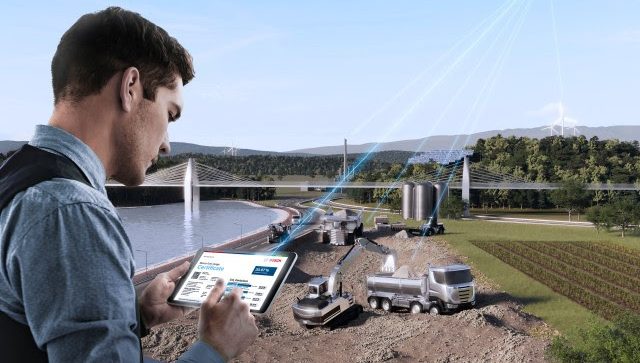Bosch Digital Fuel Twin documents the use of renewable synthetic fuels
- Digital Fuel Twin enables digital documentation and provides evidence of climate-friendly fleet operation
- The Bosch solution makes all important data on fuel properties and quantities used available via the cloud.
- Digital Fuel Twin paves the way for combustion vehicles to run on carbon-neutral fuels.
Vehicle fleets are a driver of carbon dioxide emissions, particularly for freight forwarders and transport companies. Opting to use renewable synthetic fuels can greatly reduce their carbon footprint – but documenting this, say for sustainability reports, is a challenge. That’s precisely where Bosch’s Digital Fuel Twin comes in: this software solution, integrated into the vehicle, records the use of climate-friendly fuels and documents the reduced carbon emissions. “Bosch’s Digital Fuel Twin makes it easy for companies to prove that they’re using renewable synthetic fuels,” says Thomas Pauer, the president of Bosch’s Power Solutions division. “It gives them auditable proof of the quantities and the carbon footprint of the fuel used per vehicle, which they can then use in their reporting.” In this way, companies not only comply with ever increasing reporting obligations, but can also document their environmental awareness. The Digital Fuel Twin is currently being used on the Tour d’Europe for the first time, which will also stop off at Bosch in Feuerbach on May 28. This rally to Brussels will see a fleet of cars and trucks with combustion engines refueling exclusively with renewable synthetic fuels at public filling stations as they make their way across Europe
“Bosch’s Digital Fuel Twin makes it easy for companies to prove that they’re using renewable synthetic fuels. It gives them auditable proof of the quantities and the carbon footprint of the fuel used per vehicle, which they can then use in their reporting.“
Thomas Pauer, the president of Bosch’s Power Solutions division
A further field of application for the Digital Fuel Twin would open up in the event that it becomes possible to reclassify vehicles with combustion engines as zero-emission vehicles if they use only renewable synthetic fuels. The EU intends to review this option this year. Its current plan starting in 2035 is to fine all manufacturers of combustion vehicles at such a high level as to make it no longer economically viable to sell them. “Renewable synthetic fuels should be a part of the solution. That’s the only way to achieve the climate targets in the transport sector,” Pauer says. “If the EU decides in favor of reclassification, the Digital Fuel Twin can be an important tool in implementing that.”
Purely digital records, plausibility checks, and documentation
The new Bosch software enables the reliable tracking of all a fuel’s climate-relevant properties: from production through all stages of the supply chain to the filling station and into the vehicle. To begin with, manufacturers of renewable synthetic fuels report to Bosch how much fuel they have sold, to whom, and what the fuel’s carbon footprint is. Transport companies in turn report how much fuel they purchased and when. The Digital Fuel Twin compares this data. If the time and quantity match both in the respective company books and with the recorded pump and sensor data of the transfer interfaces, the fuel properties – the type of fuel, its CO2 content, and reduction potential – are passed on in the supply chain. Any carbon emitted during further transportation is reassigned to the fuel – meaning the shorter the distances, the better for the climate. Finally, at the filling station, a “digital handshake” – an exchange of data between the filling station, vehicle, and cloud – documents exactly how much and what kind of fuel was purchased. Identification is carried out using, for example, a fleet management system. This database provides users of the Digital Fuel Twin with reliable information about the CO2 values of the fuel used as well as auditable proof of use. The fuel data is always mapped digitally as a virtual twin in a protected data room in the cloud. Bosch’s software solution can be used in cars, trucks, and buses, but also in construction vehicles and even ships.
The Digital Fuel Twin is currently undergoing testing in collaboration with many participants along the entire fuel supply chain. The system’s reliability and safety is being tested together with them and with vehicle manufacturers. To date, the Digital Fuel Twin has been retrofitted into vehicles. In the future, however, the plan is to integrate it into the vehicle’s own electronics as a pure software module, thereby ensuring the tamper-proof use of renewable synthetic fuels at the individual vehicle level. “We expect the Digital Fuel Twin to feature in production vehicles as early as 2026,” Pauer says
Renewable synthetic fuels have been available for many years
Renewable synthetic fuels are produced either from plant-based materials or with the help of renewable electricity. In contrast to fuels based on crude oil, they do not release any additional carbon dioxide into the atmosphere. Some of these fuels have been available for years. The most widely used is HVO100 (100 % recycled hydrotreated vegetable oils), which is obtained from waste oils and plant residues. Overall – taking into account the carbon emissions of the fuel itself plus the carbon emitted during its production (“well-to-wheel”) – this diesel fuel offers a CO2 advantage of up to 90 percent compared to its crude oil counterpart. Sales of this fuel have been freely permitted in Germany since 2024, but it has been available for much longer in countries such as Sweden and the Netherlands. For gasoline engines, there is also the ethanol-based fuel E85. Both fuels, HVO100 and E85, are each already available at more than 5,000 filling stations across Europe.








